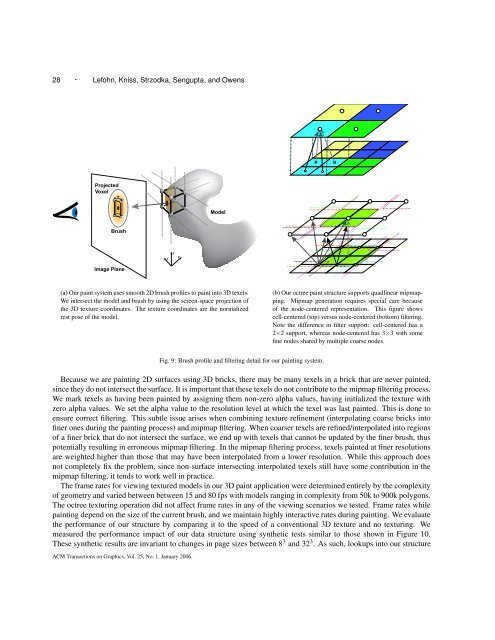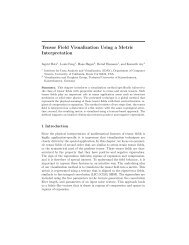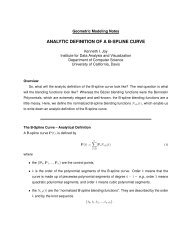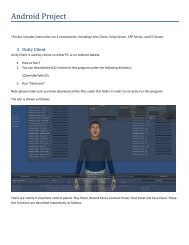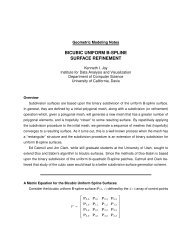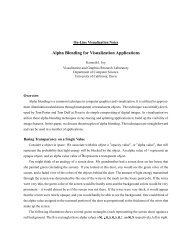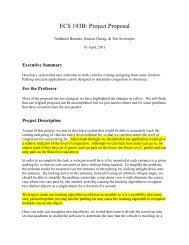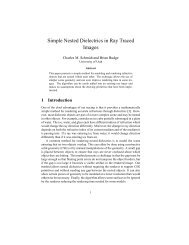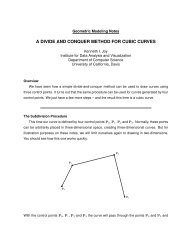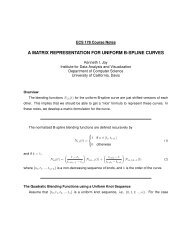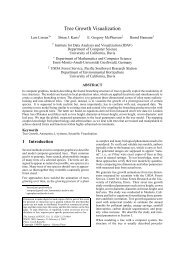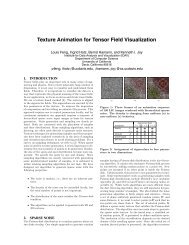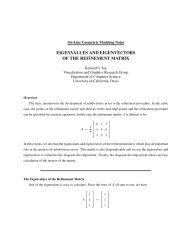28 · Lefohn, Kniss, Strzodka, Sengupta, <strong>and</strong> OwensProjectedVoxelModelBrushImage Planes t r(a) Our paint system uses smooth 2D brush profiles to paint into 3D texels.We intersect the model <strong>and</strong> brush by using the screen-space projection ofthe 3D texture coordinates. The texture coordinates are the normalizedrest pose of the model.(b) Our octree paint structure supports quadlinear mipmapping.Mipmap generation requires special care becauseof the node-centered representation. This figure showscell-centered (top) versus node-centered (bottom) filtering.Note the difference in filter support: cell-centered has a2×2 support, whereas node-centered has 3×3 with somefine nodes shared by multiple coarse nodes.Fig. 9: Brush profile <strong>and</strong> filtering detail <strong>for</strong> our painting system.Because we are painting 2D surfaces using 3D bricks, there may be many texels in a brick that are never painted,since they do not intersect the surface. It is important that these texels do not contribute to the mipmap filtering process.We mark texels as having been painted by assigning them non-zero alpha values, having initialized the texture withzero alpha values. We set the alpha value to the resolution level at which the texel was last painted. This is done toensure correct filtering. This subtle issue arises when combining texture refinement (interpolating coarse bricks intofiner ones during the painting process) <strong>and</strong> mipmap filtering. When coarser texels are refined/interpolated into regionsof a finer brick that do not intersect the surface, we end up with texels that cannot be updated by the finer brush, thuspotentially resulting in erroneous mipmap filtering. In the mipmap filtering process, texels painted at finer resolutionsare weighted higher than those that may have been interpolated from a lower resolution. While this approach doesnot completely fix the problem, since non-surface intersecting interpolated texels still have some contribution in themipmap filtering, it tends to work well in practice.The frame rates <strong>for</strong> viewing textured models in our 3D paint application were determined entirely by the complexityof geometry <strong>and</strong> varied between between 15 <strong>and</strong> 80 fps with models ranging in complexity from 50k to 900k polygons.The octree texturing operation did not affect frame rates in any of the viewing scenarios we tested. Frame rates whilepainting depend on the size of the current brush, <strong>and</strong> we maintain highly interactive rates during painting. We evaluatethe per<strong>for</strong>mance of our structure by comparing it to the speed of a conventional 3D texture <strong>and</strong> no texturing. Wemeasured the per<strong>for</strong>mance impact of our data structure using synthetic tests similar to those shown in Figure 10.These synthetic results are invariant to changes in page sizes between 8 3 <strong>and</strong> 32 3 . As such, lookups into our structureACM Transactions on Graphics, Vol. 25, No. 1, January 2006.
Glift: Generic, Efficient, R<strong>and</strong>om-Access GPU <strong>Data</strong> Structures · 29Method Cg ops HW opsStream 1D→2DGlift, no specialization 8 5Glift, with specialization 5 4Brook (<strong>for</strong> reference) — 4H<strong>and</strong>coded Cg 4 31D sparse, uni<strong>for</strong>m 3D→3D page tableGlift, no specialization 11 8Glift, with specialization 7 5H<strong>and</strong>coded Cg 6 5Adaptive shadow map + offsetGlift, no specialization 31 10Glift, with specialization 27 10H<strong>and</strong>coded Cg 16 9Table III: Comparison of instruction counts <strong>for</strong> various compilation methods on 3 memory access routines. “Cg ops” indicates the number ofoperations reported by the Cg compiler be<strong>for</strong>e driver optimization; “HW ops” indicates the number of machine instructions (“cycles”), includingmultiple operations per cycle, after driver optimization, as reported by the NVIDIA shader per<strong>for</strong>mance tool NVShaderPerf.are bound by the address translation instructions rather than the memory accesses (see Section 8).7. RESULTS7.1 Static <strong>Analysis</strong> of Glift GPU CodeGPU programmers will not use abstractions if they impose a significant per<strong>for</strong>mance penalty over writing low-levelcode. Consequently our framework must be able to produce code with comparable efficiency to h<strong>and</strong>coded routines.We evaluate the efficiency of our code by comparing instruction count metrics <strong>for</strong> three coding scenarios: a h<strong>and</strong>codedimplementation of our data structure accesses <strong>and</strong> Glift code generated with Cg both be<strong>for</strong>e <strong>and</strong> after driver optimization.We compare these metrics in Table 7.1 on three address translators: a 1D→2D stream translator, a 1-levelnon-adaptive page table, <strong>and</strong> the adaptive page table lookup used <strong>for</strong> adaptive shadow maps in Section 6.4 combinedwith an additional call to compute the page offset. This last case is a particularly difficult one <strong>for</strong> optimization becauseit contains a numerous redundant instructions executed by multiple method calls on the same structure.All results in this section were computed on a 2.8 GHz Pentium 4 AGP 8x system with 1 GB of RAM <strong>and</strong> anNVIDIA GeForce 6800 GT with 256 MB of RAM, running Windows XP. The NVIDIA driver version was 75.80 <strong>and</strong>the Cg compiler is version 1.4 beta.The results <strong>for</strong> these address translators <strong>and</strong> others we have tested show that the per<strong>for</strong>mance gap between programmingwith Glift <strong>and</strong> h<strong>and</strong>coding is minimal if any. The careful use of partial template specialization, Cg programspecialization, <strong>and</strong> improved optimizations of recent compilers <strong>and</strong> drivers make it possible to express abstract structureswith very little or no per<strong>for</strong>mance penalty.7.1.1 Memory Access Coherency. Like their CPU counterparts, many GPU data structures use one or more levelsof memory indirection to implement sparse or adaptive structures. This section assesses the cost of indirect GPUmemory accesses <strong>and</strong> the relative importance of coherency in those accesses. Examples include page-table structuressuch the adaptive data structure described in Section 6.3.1 <strong>and</strong> tree structures [Foley <strong>and</strong> Sugerman 2005; Lefebvreet al. 2004; Thrane <strong>and</strong> Simonsen 2005].This evaluation provides guidance in choosing the page size <strong>and</strong> number of levels of indirection to use in an addresstranslator. We evaluate the per<strong>for</strong>mance of 1- <strong>and</strong> 2-level page tables built with Glift as well as n-level chained indirectlookups with no address translation between lookups (see Figure 10). The experiment simulates memory accessesper<strong>for</strong>med by paged structures by per<strong>for</strong>ming coherent accesses with page-sized regions, but r<strong>and</strong>omly distributingthe pages in physical memory. As such, the memory accesses are completely r<strong>and</strong>om when the page size is one (singlepixel). Accesses are perfectly coherent when the page size is the entire viewport. To validate our experimental setup,ACM Transactions on Graphics, Vol. 25, No. 1, January 2006.
- Page 6 and 7: 6 · Lefohn, Kniss, Strzodka, Sengu
- Page 8 and 9: 8 · Lefohn, Kniss, Strzodka, Sengu
- Page 10 and 11: 10 · Lefohn, Kniss, Strzodka, Seng
- Page 12 and 13: 12 · Lefohn, Kniss, Strzodka, Seng
- Page 14 and 15: 14 · Lefohn, Kniss, Strzodka, Seng
- Page 16 and 17: 16 · Lefohn, Kniss, Strzodka, Seng
- Page 18 and 19: 18 · Lefohn, Kniss, Strzodka, Seng
- Page 20 and 21: 20 · Lefohn, Kniss, Strzodka, Seng
- Page 22 and 23: 22 · Lefohn, Kniss, Strzodka, Seng
- Page 24 and 25: 24 · Lefohn, Kniss, Strzodka, Seng
- Page 26 and 27: 26 · Lefohn, Kniss, Strzodka, Seng
- Page 30 and 31: 30 · Lefohn, Kniss, Strzodka, Seng
- Page 32 and 33: 32 · Lefohn, Kniss, Strzodka, Seng
- Page 34 and 35: 34 · Lefohn, Kniss, Strzodka, Seng
- Page 36 and 37: 36 · Lefohn, Kniss, Strzodka, Seng


